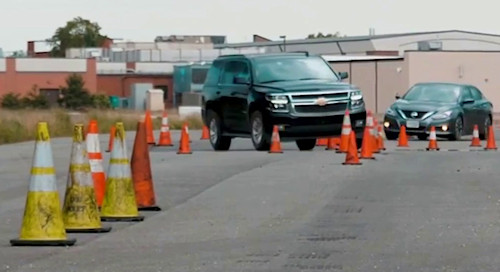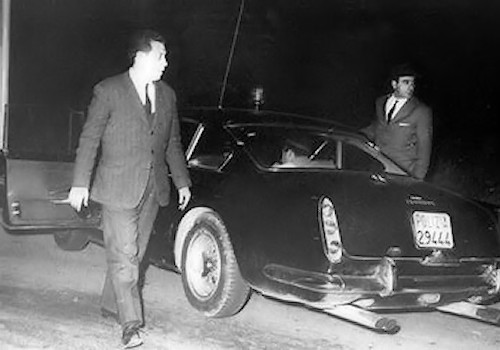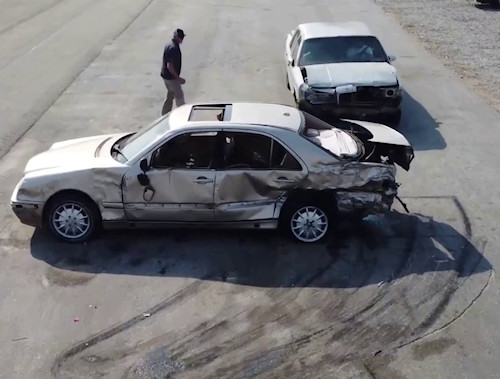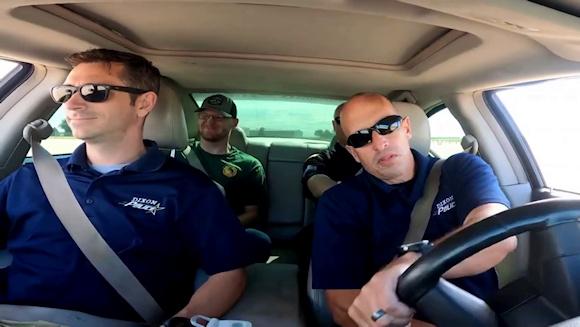Over the years we have extensively described the tactical and logistics vehicles of our armed forces, especially the Army. We focused on the professionalism and preparation that the Army sets as a goal for its operators, thanks to the numerous sessions with technical tests off road even at night and hostile terrain simulations.
Another technical aspect and subject of study, at least in the USA, is driving under attack. An attack that can most often be fire or otherwise generated by other vehicles.
If on this topic where you can talk about guidelines, the country that invests most in tactical guidance - defensive and offensive - is the United States which also organizes dedicated courses with clear procedures for the US Army. It must be premised that Italy is absolutely second to no other country in the world in terms of safe driving courses, defensive driving and so on, even if the vocation has closer links with safety and competition.
Some examples of the concept of security under attack? A hypothetical businessman who wants to know some evasive driving techniques in the event of robbery, the formation of a nucleus of conductors assigned to the escort service ("more advanced" concept of protection), rather than the training of soldiers on patrol in areas at risk.
Mental preparation is the first goal
 Being forced to make evolutions with the car is not a habit for anyone given the clear margin of risk to be estimated, a risk that must justify the action. Spinning without proper training is as disorienting as braking to the limit without warning.
Being forced to make evolutions with the car is not a habit for anyone given the clear margin of risk to be estimated, a risk that must justify the action. Spinning without proper training is as disorienting as braking to the limit without warning.
Keeping calm during exercises is not a given. It is necessary to try continuously because there is no such thing as perfection, perhaps only the "automatic gesture". Considering the many skills that the military must assimilate, the courses do not churn out "sports" driving professionals, rather, personnel aware of the risks and capable of controlling the vehicle in critical conditions.
The driving training training area includes two “tactical” concepts: defensive and offensive driving. The repeated exercises are meant to broaden the military's skills by staying in their thought processes and muscle memory by purposely creating high stress situations.
The various threats and types of ambushes are studied, understanding the dynamics and physics related to a vehicle. We even understand the dynamic behavior of the armored platforms, very different from the unprotected ones.
The concept of defensive driving can be summarized in the training to know how to foresee a danger, even a pedestrian, a cyclist or an ambush. Offensive driving includes a set of maneuvers and types of gear aimed at overpowering the enemy by "forcing" the common rules.
In addition to sudden danger avoidance techniques, controlled ramming is studied.

The J-turn
When I practiced and illustrated this exercise I called it rectilinear dynamic operating inversion, the easier it is to call it J-turn as happens at EVOC, the academy of Emergency Vehicle Operator Course In the USA. A stress for the axle shafts (I ripped one out of its seat), transmission and gearbox of cars, but also a maneuver that cannot be performed with heavy vehicles.
The US Army Military Police School at Fort Leonard Wood relies on EVOC for operational driving training.
What is a J-turn? A vehicle advances suddenly finding the road blocked and perhaps some assailants in front of the vehicle ready to fire. So the driver must engage reverse gear along a straight stretch and then cause the front end to skid, finding himself facing in the opposite direction and be ready to flee. I let you imagine the excitement of the moment (in reality), even if, in the simulations, the maneuver has undoubted scenographic aspects.
This is just one of the maneuvers to evade an attack and I briefly report some details. A vehicle is made to travel mainly in one direction in which the braking effect, when reversing, is less effective. Furthermore, when reversing at high speed, it is advisable to turn your head towards the rear window; otherwise you lose control and balance. It cannot be ruled out that the maneuver involves dodging obstacles when moving backwards and the steering wheel is generally held at 12 o'clock. Taking advantage of the rear pitch, the gas is released and the vehicle swerved quickly, forcing the mass of the vehicle to realign the car in the opposite direction pivoting on the rear axle. A maneuver where you have to be lightning fast when engaging first gear and sinking on the accelerator to stabilize the car.
Some of the more frequent technical questions on the maneuver are: why can't it be done with heavy vehicles? A. The height and reduced maneuverability could lead to a rollover.
How is this feasible with a modern automatic transmission that does not recognize the gear position on the go? The vehicles adopted for these purposes generally have particular modifications in the software to make the maneuver even faster. I would add that the manual gearbox is more suitable in terms of sturdiness to be solicited. The Alfa Romeo 33 1.7, 155 and the Lancia Thema 2.0 turbo were excellent for operational learning.
Detached control systems
Understanding on which road surface the maneuver is being performed is essential; the less grip there is (snow or mud) the more “atypical” dynamic movements will be facilitated. In defensive driving it is always necessary to know where we are at by adapting our every reaction. In cases of low grip road surfaces, even a heavy tactical vehicle could risk an elusive manoeuvre. The modern presence of integral traction should be considered full time (non-excludable) designed to ensure constant grip on all wheels, a condition that rewards single tractions more in the J manoeuvre.
 Deactivating traction and stability control are some of the expedients that increase mastery of the vehicle, but Marshal Armando Spatafora's times are over and everything, even the performance, is updated to current automotive technology that offers greater safety.
Deactivating traction and stability control are some of the expedients that increase mastery of the vehicle, but Marshal Armando Spatafora's times are over and everything, even the performance, is updated to current automotive technology that offers greater safety.
EVOC
Keith Watts is a professional instructor corporal in the Emergency Vehicle Operator Course and many military and police operators have passed under his teachings.
“Constant evaluation of what surrounds us is essential” says Watts on army.mil training_enhances_readiness. There are circumstances where you have to "break through" (offensive driving), others where it is better to "recede" (defensive driving).
It is necessary to find the right speed which is generally around 50 km/h to safely ram the rear wheel of a vehicle you want to stop.
There are 18 exercises that include steering, braking and reversing techniques adds Sergeant First Class James Winn, head of the emergency vehicle operations and vehicle dynamics command.
So he concludes: we teach the soldiers to brake before entering the curve by making known the points of release of the gas. Then there is the analysis of the legal and political aspects of the countries where EVOC imparts the courses, but the technical procedures do not change.

Corporal Megan Wells of the 701st Military Police Battalion reports in the news: The training is very different from civilian driving. It's violent, not because you're out of control of the vehicle, but because you have to maintain control as you maneuver through obstacles.
In effect, the training involves driving at high speed through rows of pins barely wider than the car's track. Clearly they shouldn't even be touched.
Where are the means found?
The relationship with the junkyards must be idyllic because many cars are destroyed. We opt for cars that are still running for the exercises in contact, while the non-running ones are used as a "dummy" or target. Then there are service cars that are no longer of specifications, which can also be – what a pity! – crashed, or the current service ones to which, however, the abrupt "contact" is avoided, using them to study the road characteristics and maneuvers on surfaces with low grip. This happens in the USA, but certainly also here.
When to put it into practice
It can happen to an insider at any time and without warning. Only mind training and the muscle memory (ad hoc term translated from the American article), make the difference. The parallel can be vaguely extended to operational dynamic shooting, between "good" and "bad" shapes. In a busy city, performing choreographic maneuvers with a steering wheel could have dangerous consequences for other road users. Therefore, better an assessment of the danger of the subject and the type of intervention to be implemented. In the military sector it is more exposed, but attention to the civilians present is always a priority for the operators.
 Collisions
Collisions
Instructor Keith Watts also talks about low-speed rear-wheel collisions to stop a runaway car. The maneuver allows, without the use of weapons, to put a wheel of the fleeing car out of action by making it rotate (for the push) perpendicularly to the pursuing car. On the other hand, on the escape, the surprise effect of the assailants and the understandable, albeit controlled, agitation of the attacked, can force you to have to hit other vehicles or use your own as a battering ram to open up a safe escape route. It depends on the state of necessity and on the lack of other solutions… more discreet. The training is also aimed at knowing how to find immediate answers in extreme conditions.
In the J exercise that years ago I had performed in a dedicated area, I stared at two pins out of the car's reversing trajectory. The pupil first had to channel himself into this space and then perform the forced inversion.
Sources:
EVOC training enhances readiness | Articles | The United States Army
3 High-Threat Driving Techniques Used by Military Personnel (businessinsider.com)
Frames: web / Evan Mason / PTC Driving Academy












